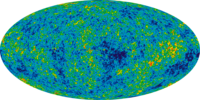
Photo from wikipedia
We calculate the sensitivity of next generation neutrino telescopes to the 28 (isoscalar and isovector) coupling constants defining the non-relativistic effective theory of (spin 1/2) dark matter (DM)-nucleon interactions. We… Click to show full abstract
We calculate the sensitivity of next generation neutrino telescopes to the 28 (isoscalar and isovector) coupling constants defining the non-relativistic effective theory of (spin 1/2) dark matter (DM)-nucleon interactions. We take as a benchmark detector the proposed Precision IceCube Next Generation Upgrade (PINGU), although our results are valid for any other neutrino telescope of similar effective volume. We express PINGU's sensitivity in terms of $5\sigma$ sensitivity contours in the DM-mass - coupling constant plane, and compare our sensitivity contours with the 90% C.L. exclusion limits on the same coupling constants that we obtain from a reanalysis of the null result of current DM searches at IceCube/DeepCore. We find that PINGU can effectively probe not only the canonical spin-independent and spin-dependent DM-nucleon interactions, but also velocity-dependent or momentum-dependent interactions that generate coherently enhanced DM-nucleus scattering cross sections. We also find that PINGU's $5\sigma$ sensitivity contours are significantly below current IceCube/DeepCore 90% C.L. exclusion limits when $b\bar{b}$ is the leading DM annihilation channel. This result shows the importance of lowering the experimental energy threshold when probing models that generate soft neutrino energy spectra, and holds true independently of the assumed DM-nucleon interaction and for all DM masses tested here. When DM primarily annihilates into $\tau\bar{\tau}$, a PINGU-like detector will improve upon current exclusion limits for DM masses below $35$ GeV, independently of the assumed DM-nucleon interaction.
Journal Title: Journal of Cosmology and Astroparticle Physics
Year Published: 2019
Link to full text (if available)
Share on Social Media: Sign Up to like & get
recommendations!